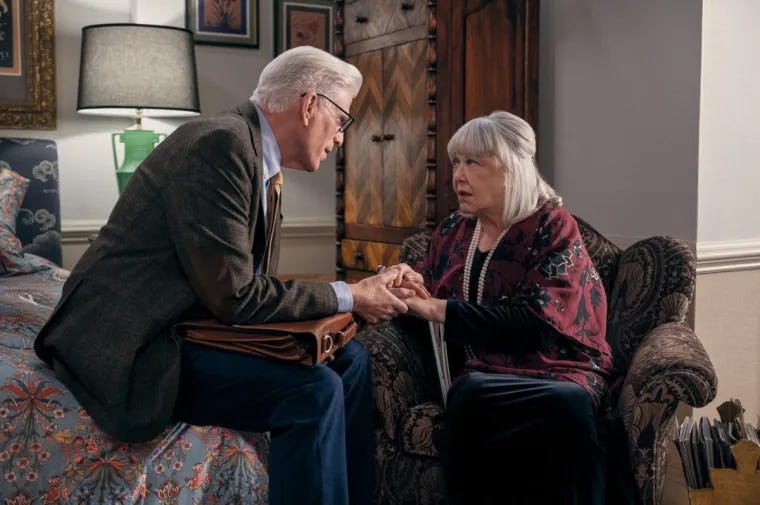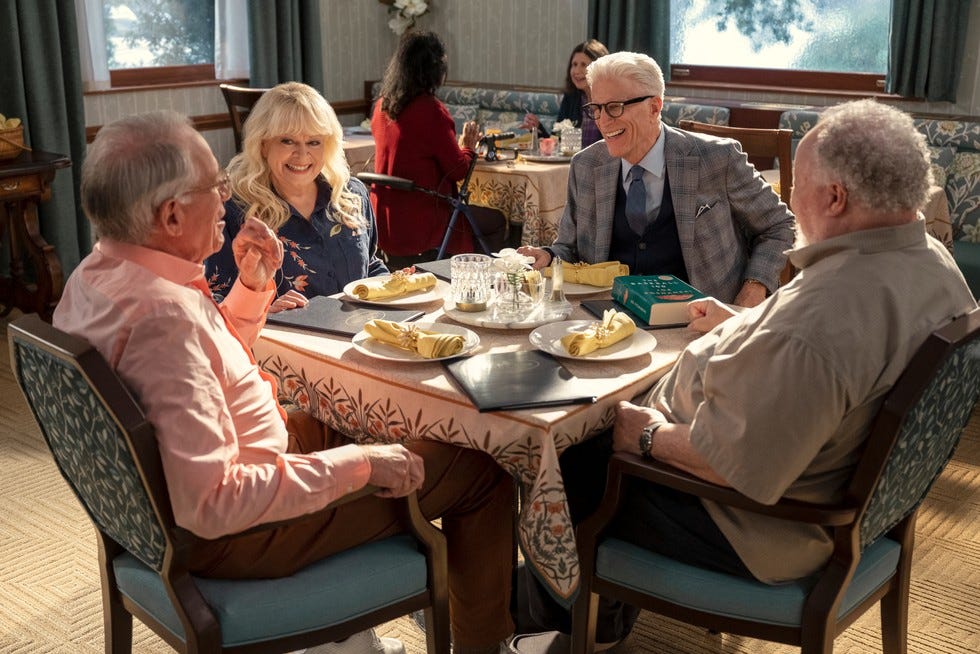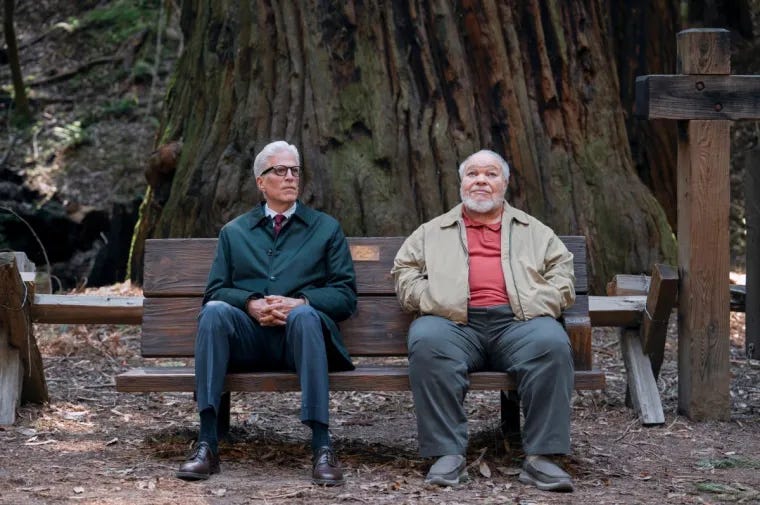A Man on the Inside: The Netflix Series That Gets Senior Living Right
What the series reveals about community life echoes what I’ve seen firsthand in Grand Prairie’s own senior living communities.
This review is part of the Adults Over 55 Channel of Faces of Grand Prairie Media Group, sponsored by Jenna Pecor, your Grand Prairie Seniors Real Estate Specialist. If you’ve ever wondered what senior living can really be, watch this show—and maybe visit one of our local communities. Jenna would love to show you around! Whether it’s for yourself or a parent, you may discover it’s not thIn this engaging, heartwarming, and funny TV show by legendary showrunner Michael Schur, Ted Danson plays Charles, a retired professor and widower who answers a newspaper ad from Julie, a young woman hired by the son of a resident at Pacific View Retirement Community. The son believes his mother’s necklace was stolen, and Julie, realizing she needs someone “on the inside,” recruits Charles as a kind of senior intern private investigator. His only test in the interview? Take a picture and send it by text message.
In this engaging, heartwarming, and funny TV show by legendary showrunner Michael Schur, Ted Danson plays Charles, a retired professor and widower who answers a newspaper ad from Julie, a young woman hired by the son of a resident at Pacific View Retirement Community. The son believes his mother’s necklace was stolen, and Julie, realizing she needs someone “on the inside,” recruits Charles as a kind of senior intern private investigator. His only test in the interview? Take a picture and send it by text message.
Having worked in senior living and memory care communities myself, I can’t tell you how much I loved this show and how realistic it felt. Schur somehow captures so many nuances of community life that it’s as if he spent years working there.
What makes this series special is how it portrays staff in assisted living as people who truly love and respect the residents. That was exactly my experience at both communities where I worked—we cared deeply, saw our residents as adults, and refused to infantilize them. There’s a particularly moving scene where Executive Director Didi (played brilliantly by Stephanie Beatriz in a role completely opposite her Rosa Diaz character from Brooklyn Nine-Nine) reminds a driver who is conflicted about taking a resident with cancer to buy cigars that he’s an adult who can make his own decisions. “Don’t infantilize him” she warns. That authenticity shines throughout the show.
Schur also nails the emotional weight of living in a senior community. In one episode, a beloved resident passes away unexpectedly. When a staff member quietly gives Didi the room number instead of the resident’s name, she instantly understands what has happened. Outside, a resident asks, “Is it Florence?” Didi, holding back tears, replies, “Virginia, you know I can’t disclose another resident’s medical information.” Virginia, a long-time resident, knows exactly what that means. That brief exchange captures both the frustrations of HIPAA and the unspoken ways residents learn to read between the lines after years of living together.
Another major theme is memory care, depicted here as “The Neighborhood”—a place residents worry about being sent “behind the door.” Charles, who cared for his wife through dementia at home and promised never to move her into memory care, finally visits when his friend Gladys is relocated there. To his surprise, he finds a warm, joyful space filled with compassionate staff and residents still living meaningful lives. This rang true for me: when dementia progresses, assisted living can feel more like chaos than freedom. Memory care often provides the safety, structure, and dignity that truly allow residents to thrive.
Gladys, like real memory care residents, isn’t hidden away—she comes out for community-wide events like birthdays and weddings. In one touching moment at their friend’s wedding, an old song plays and her face lights up with recognition. Charles sits beside her as music unlocks joy and comfort. Ted Danson is pitch-perfect in these scenes, showing the best way to connect with someone who has dementia: not correcting them, but entering their world, following their memories, and honoring the life still alive inside them. Having spent hours listening to residents relive the first song they heard as teenagers, the childhood street they grew up on, or the day they were drafted into the NFL (yes—one of my residents scored the first touchdown in Super Bowl I!), I can say this portrayal is beautifully accurate.
One of the most fun characters is Beatrice, a wealthy woman who volunteers as the community’s activities director. She doesn’t need the work, but she adores the residents and finds joy in planning their days. That’s not uncommon—in fact, I’ve often said that if money were no object, I’d go back and be an activities director myself. Joining residents in their crafts, games, and celebrations was always the highlight of my day.
The show understands the tenderness and terror of starting over socially. Early on, after Charles moves into Pacific View, he steels himself to try breakfast in the dining room. He walks in, scans for a seat, can’t immediately find one, panics, and retreats to his room. I cannot tell you how accurate that is. There’s no age where meeting new friends gets easy, and “finding a seat in the lunchroom” never stops being intimidating. I once discussed that very feeling with a circle of residents—and had almost the same conversation that night with my sixth grader. Social anxiety is human. But so is the joy that follows when you push through. Charles does, and he finds his table—and his people. That’s the show’s quiet thesis: moving into “The Home” isn’t the beginning of the end; for many, it’s the start of another act—friendships, parties, romance, freedom, and respect.
The heart of The Man on the Inside lies in Charles’ transformation. At the start, we see him living alone in a beautiful yet isolating home, filling his days with meaningless routines—like mailing random newspaper clippings to his daughter, just so he has an excuse to step outside. His world feels stagnant, repetitive, and small. But everything shifts when he moves into Pacific View. There, he doesn’t just find neighbors—he discovers friends, purpose, and a renewed sense of belonging. What begins as the end of one chapter becomes the vibrant beginning of another, filled with laughter in the dining hall, late-night games, unexpected romances, and a freedom he thought he’d lost. Charles’ life doesn’t wind down—it opens up.
The show also highlights something often overlooked: the men’s perspective. Charles finds a friend in Calbert, and together they spend hours playing backgammon and exploring San Francisco’s engineering marvels. So many men in senior communities are veterans, engineers, and builders, yet communities often fail to engage them meaningfully. Women tend to find purpose in friendships and social activities; men often find it in being useful. Charles only agrees to move in because he has a “job” to do. That’s something I wish communities embraced more: give men projects, let them help with maintenance, build planters, fix things, solve problems. That’s what so many love—waking up, having coffee, going to the diner to meet friends and solve the world’s problems, then going home to solve their own, whether it’s tinkering in the garage, tending to the yard, or tackling the honey-do list.
This idea of a senior “intern” is one of my favorite parts of the show. Julie knew the only way to solve her case was to bring someone between 75–85 “on the inside.” It’s a brilliant reminder that seniors have unique skills and perspectives to contribute. Personally, I’ve incorporated seniors into several of my own projects and have grand plans to keep doing so through Faces of Grand Prairie Media Group. Their voices, experience, and creativity are invaluable—and too often untapped.
I’ve worked at Morada Senior Living in Westchester, Cedar Creek Assisted Living and Memory Care in Mansfield, and I regularly visit Mountain Creek Retirement Community in Grand Prairie. All of them are beautiful, with excellent food, caring staff, and vibrant lifestyles. I wish more people could see senior living as it really is today—a thriving community, not the nursing homes of the 1980s where residents sat in wheelchairs lifeless and forgotten.
Show Review: A+






